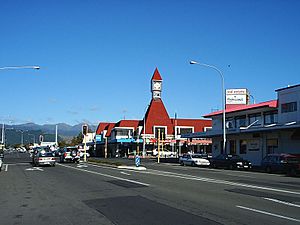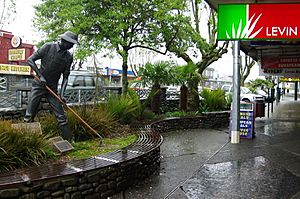Levin, New Zealand facts for kids
Quick facts for kids
Levin
Taitoko (Māori)
|
|
|---|---|
|
Secondary urban area
|
|

Intersection of Queen and Oxford Streets
|
|
| Country | New Zealand |
| Region | Manawatū-Whanganui |
| Territorial authority | Horowhenua District |
| Wards |
|
| Named for | William Hort Levin |
| Electorates |
|
| Area | |
| • Urban | 22.91 km2 (8.85 sq mi) |
| Population
(June 2023)
|
|
| • Urban | 19,800 |
| • Urban density | 864.3/km2 (2,238/sq mi) |
| Postcode |
5510
|
| Area code(s) | 06 |
Levin (pronounced luh-VIN) is a lively town in New Zealand. It is the biggest town in the Horowhenua District. You can find it in the Manawatū-Whanganui region, on the North Island.
Levin is located east of Lake Horowhenua. It is about 95 kilometers north of Wellington. It is also about 50 kilometers southwest of Palmerston North.
The town has a population of about 19,800 (June 2023), making it the 30th largest urban area in New Zealand. It is also the third largest in its region.
Levin is a helpful hub for the farms around it. It is also a place where many light manufacturing businesses operate.
West of the main town is Lake Horowhenua. This lake covers about 3.9 square kilometers. Efforts are being made to make the lake healthy again.
Contents
History of Levin
Early Days: 19th Century
The area where Levin is today got its first railway connections in 1886. These railways linked it to both Wellington and Palmerston North.
In 1888, the land was officially measured and mapped. People from Europe started settling there in 1889. They bought pieces of land starting on March 19, 1889.
The town was named after William Hort Levin. He was a director of the Wellington and Manawatu Railway Company.
The name Levin comes from the Jewish family name Levi. Usually, the name is pronounced with the stress on the first part. However, in Levin, the stress is on the second part of the word. William Hort Levin's great-grandson, Peter Levin, says his ancestor said his name as Levene. This pronunciation was common for many years in the family.
Modern Times: 20th Century to Today
Levin officially became a borough in 1906. This means it became a self-governing town.
The Levin clock tower was built in 1999. The Levin Rotary Club raised money and donated it to the town. Many people see it as a symbol of Levin. The tower has four clocks, one on each side. Each clock has its own motor. It also shows the temperature.
Car Gathering in 2024
On Saturday, June 1, 2024, a large gathering of cars took place. It was known locally as "the Levin car invasion." About 200 cars and 500 people were there. They started at the intersection of Queen Street and State Highway 57. The police then guided them to move.
The group then went to Miro Street in Ōtaki. After that, they returned to Levin. They arrived at the intersection of State Highway 1 and Queen Street. The police worked to manage the large group. An organizer mentioned that they wanted a safe place for car activities.
Marae: Māori Meeting Places
Levin is home to important Māori meeting places called marae.
- Kawiu Marae and its meeting house, Te Huia o Raukura, are just north of town. This is a special place for the Muaūpoko people.
- In October 2020, the government helped upgrade Kawiu Marae. They also upgraded nearby Kohuturoa Marae. This project helped create 50 jobs for people in the area.
Population and People
Levin is considered a medium-sized urban area by Statistics New Zealand. It covers about 22.91 square kilometers. Its estimated population is 19,800 as of June 2023, with many people living per square kilometer.
The population of Levin has grown over the years:
- In 2006, there were 15,972 people.
- In 2013, the population was 16,257.
- By 2018, it had grown to 17,679 people.
In 2018, there were 7,062 homes in Levin. There were 8,346 males and 9,324 females. About 18.9% of the people were under 15 years old. About 26.6% were 65 or older.
Most people in Levin are of European/Pākehā background (77.0%). A good number are Māori (25.4%). There are also people of Pasifika (8.4%) and Asian (5.2%) backgrounds.
About 16.3% of people in Levin were born overseas. This is less than the national average for New Zealand.
When asked about religion, 47.6% said they had no religion. About 39.4% were Christian. Smaller numbers followed Māori religious beliefs, Hindu, Muslim, or Buddhist faiths.
Economy and Shopping
Shopping in Levin
The Levin Mall is a place where people can shop. It has 14 different stores. One of the main stores is a Farmers department store.
Getting Around: Transport
Levin is located on State Highway 1. This highway is the town's main street, called Oxford Street. State Highway 57 runs along the eastern side of the town. It connects with State Highway 1 between Levin and the Ohau River.
Levin is also on the main railway line of the North Island. The station is used by the Capital Connection train. This train carries people between Wellington and Palmerston North.
Buses are also available for transport. There are buses for shoppers to Waikanae on Tuesdays and Thursdays. On Fridays, buses go to Shannon, Foxton Beach, Foxton, and Waitarere Beach. A special bus also runs from Foxton to Palmerston North for commuters.
Schools in Levin
There are nine schools in the Levin area. They help educate children from primary to secondary levels.
- Fairfield School is a state primary school for Years 1–8.
- Horowhenua College is a state secondary school for Years 9–13. It opened in 1940.
- Levin East School is a state primary school for Years 1–6.
- Levin Intermediate is a state intermediate school for Years 7–8.
- Levin North School is a state primary school for Years 1–6.
- Levin School is a state primary school for Years 1–6.
- St Joseph's School is a state-integrated Catholic primary school for Years 1–8.
- Taitoko School is a state primary school for Years 1–8.
- Waiopehu College is a state secondary school for Years 9–13. It opened in 1973.
Famous People from Levin
Many talented people have come from Levin. Here are a few:
- Jack Afamasaga – a rugby league player
- Sir Paul Beresford – a British politician
- Suzy Clarkson – a newsreader
- Joy Cowley – a well-known novelist
- Jaxon Evans – a racing driver
- Rebecca Gibney – an actress
- Nathan Guy – a politician
- Nicky Hager – an author
- Dean Kent – an Olympic swimmer
- David Lomax – a rugby league player
- Matthew Saunoa – winner of New Zealand Idol in 2006
- George Silk – a famous photographer for LIFE magazine
- Carlos Spencer – a rugby union player
- James Tamou – a rugby league player
- Codie Taylor – a rugby union player
- Roger Twose – a cricketer
Images for kids
See also
 In Spanish: Levin (Nueva Zelanda) para niños
In Spanish: Levin (Nueva Zelanda) para niños




